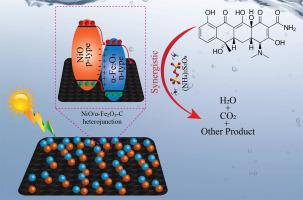Peroxydisulfate-enhanced photocatalytic degradation of Tetracycline using NiO/α-Fe2O3-C derived from hierarchical NiFe Prussian blue analogue via seed-mediated growth
IF 6.7
2区 工程技术
Q1 ENGINEERING, CHEMICAL
引用次数: 0
Abstract
Antibiotics in the environment pose ecological risks and promote drug resistance. Heterostructure photocatalysts offer a solution but are often hindered by charge carrier recombination. Integrating photocatalysis with peroxydisulfate (PDS) activation mitigates this issue by enhancing charge separation. Herein, we report for the first time the synthesis of a NiO/α-Fe2O3-C p–n heterojunction via an epitaxial hierarchical NiFe Prussian blue analogue via seed-mediated growth template, followed by thermal oxidation, enabling efficient visible-light-driven PDS activation for tetracycline degradation. This PBA-derived approach allows precise control over composition and interface structure, resulting in superior ROS generation compared to conventional heterojunction fabrication methods. The catalyst achieved 87.67 % tetracycline degradation (2 mg/30 mL catalyst, 2.5 mM/L PDS, pH 5.5, 150 min) with a pseudo-first-order rate constant of 0.025 min−1, attributed to the synergistic production of O2•−, h+, SO4•− and •OH. Notably, the NiO/α-Fe2O3-C exhibited remarkable recyclability and reusability, maintaining high degradation efficiency even after six consecutive cycles. This work introduces a novel, scalable PBA-templated strategy for constructing high-performance heterojunction photocatalysts, offering a sustainable pathway for industrial wastewater remediation.

NiO/α-Fe2O3-C对四环素的光催化降解研究
环境中的抗生素造成生态风险,促进耐药性。异质结构光催化剂提供了一种解决方案,但常常受到载流子复合的阻碍。整合光催化与过硫酸氢盐(PDS)活化通过增强电荷分离减轻了这一问题。在此,我们首次报道了通过种子介导的生长模板,通过外延分层NiFe普鲁士蓝类似物合成NiO/α-Fe2O3-C p-n异质结,然后进行热氧化,实现了高效的可见光驱动PDS激活,用于四环素降解。这种衍生的方法可以精确控制组成和界面结构,与传统的异质结制造方法相比,产生优越的ROS。该催化剂(2 mg/30 mL催化剂,2.5 mM/L PDS, pH 5.5, 150 min)的四环素降解率为87.67%,准一级速率常数为0.025 min−1,主要归因于O2•−、h+、SO4•−和•OH的协同生成。值得注意的是,NiO/α-Fe2O3-C具有良好的可回收性和可重复使用性,即使在连续6次循环后仍保持较高的降解效率。这项工作介绍了一种新颖的,可扩展的pba模板策略,用于构建高性能异质结光催化剂,为工业废水修复提供了可持续的途径。
本文章由计算机程序翻译,如有差异,请以英文原文为准。
求助全文
约1分钟内获得全文
求助全文
来源期刊

Journal of water process engineering
Biochemistry, Genetics and Molecular Biology-Biotechnology
CiteScore
10.70
自引率
8.60%
发文量
846
审稿时长
24 days
期刊介绍:
The Journal of Water Process Engineering aims to publish refereed, high-quality research papers with significant novelty and impact in all areas of the engineering of water and wastewater processing . Papers on advanced and novel treatment processes and technologies are particularly welcome. The Journal considers papers in areas such as nanotechnology and biotechnology applications in water, novel oxidation and separation processes, membrane processes (except those for desalination) , catalytic processes for the removal of water contaminants, sustainable processes, water reuse and recycling, water use and wastewater minimization, integrated/hybrid technology, process modeling of water treatment and novel treatment processes. Submissions on the subject of adsorbents, including standard measurements of adsorption kinetics and equilibrium will only be considered if there is a genuine case for novelty and contribution, for example highly novel, sustainable adsorbents and their use: papers on activated carbon-type materials derived from natural matter, or surfactant-modified clays and related minerals, would not fulfil this criterion. The Journal particularly welcomes contributions involving environmentally, economically and socially sustainable technology for water treatment, including those which are energy-efficient, with minimal or no chemical consumption, and capable of water recycling and reuse that minimizes the direct disposal of wastewater to the aquatic environment. Papers that describe novel ideas for solving issues related to water quality and availability are also welcome, as are those that show the transfer of techniques from other disciplines. The Journal will consider papers dealing with processes for various water matrices including drinking water (except desalination), domestic, urban and industrial wastewaters, in addition to their residues. It is expected that the journal will be of particular relevance to chemical and process engineers working in the field. The Journal welcomes Full Text papers, Short Communications, State-of-the-Art Reviews and Letters to Editors and Case Studies
 求助内容:
求助内容: 应助结果提醒方式:
应助结果提醒方式:


